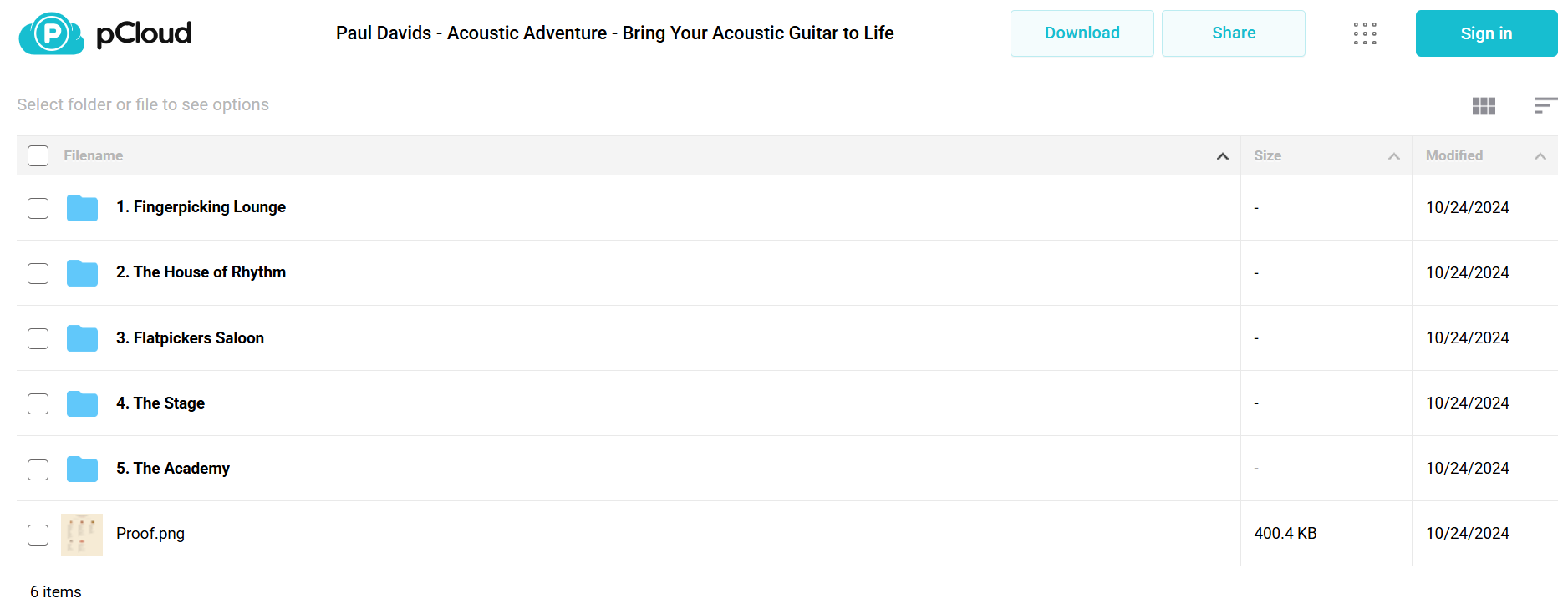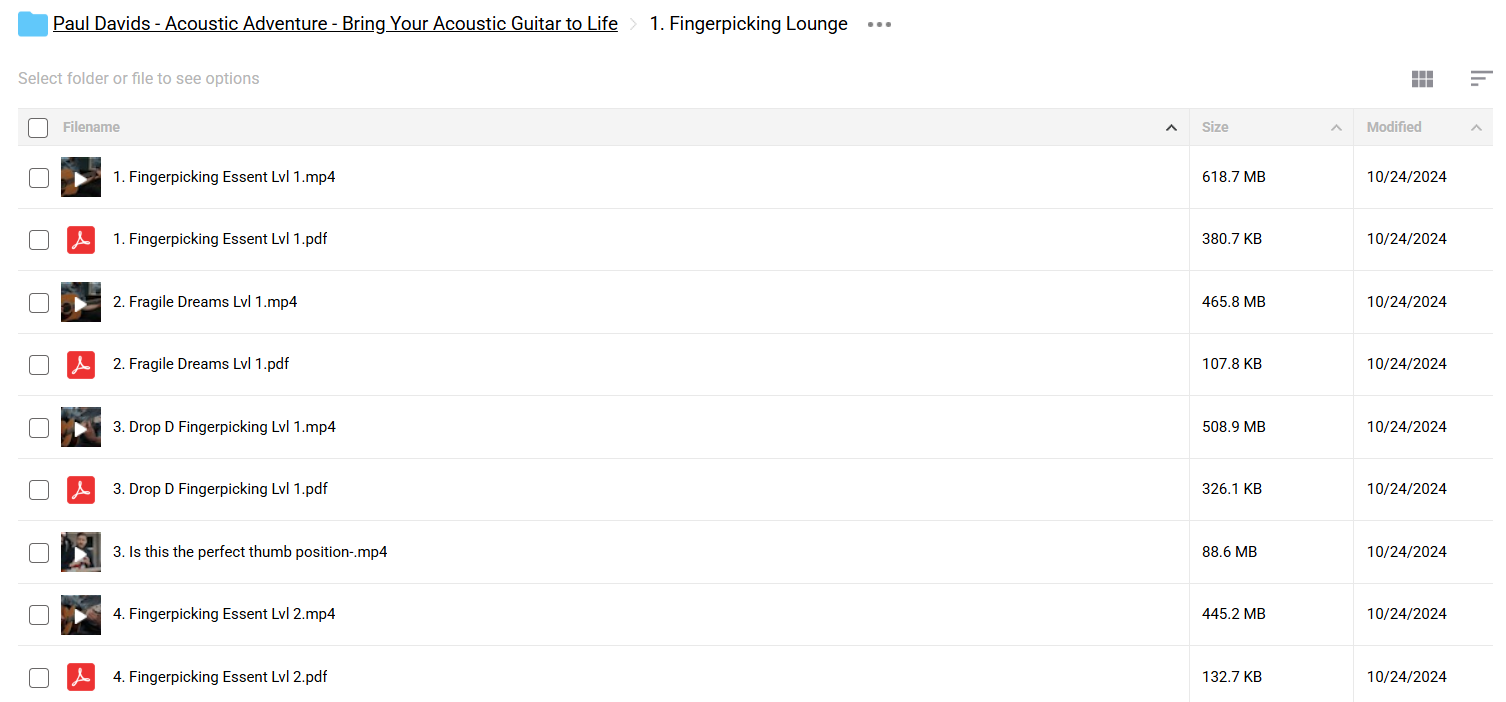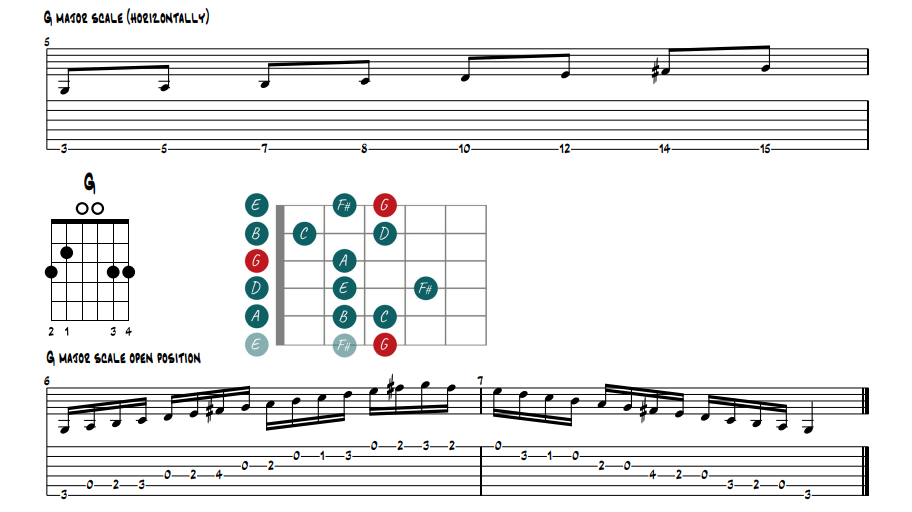Paul Davids – Acoustic Adventure – Bring Your Acoustic Guitar to Life
$199.00 Original price was: $199.00.$43.00Current price is: $43.00.
Paul Davids Acoustic Adventure Course [Instant Download]

1️⃣. What is Paul Davids Acoustic Adventure?
Paul Davids Acoustic Adventure is a guitar course for intermediate players who want to improve their acoustic guitar skills.
The program teaches various playing techniques including fingerpicking, rhythm techniques, and flatpicking through original compositions.
YouTube guitar educator Paul Davids created this comprehensive course to give guitarists a clear path to mastering enjoyable and rewarding acoustic techniques across different musical styles.
Students learn how to bring their acoustic guitar playing to life by discovering the rich sounds possible with proper technique.
📚 PROOF OF COURSE



2️⃣. What you’ll learn in Acoustic Adventure:
Paul Davids Acoustic Adventure helps you move from basic strumming to more colorful, rich guitar playing. Here’s what you’ll learn:
- Fingerpicking skills: Key patterns, Travis picking, blues fingerstyle, and playing melodies with chords
- Better rhythm playing: Go beyond basic strumming with basslines, muted strums, and drum-like sounds
- Flatpicking techniques: Add cool licks, runs, and decorations to make your playing stand out
- Mix different styles: Combine elements from blues, folk, bluegrass, and modern acoustic music
- Better guitar sound: Get a clearer, fuller tone from your acoustic guitar
- Practical music theory: Use scales, chord progressions, and chord additions in real songs
This course works best for players who already know the basics and want to make their acoustic guitar sound more interesting while having fun learning.
3️⃣. Acoustic Adventure Course Curriculum:
✅ Module 1: Fingerpicking Lounge
This module focuses on developing your fingerstyle technique from basic patterns to complex arrangements. Students begin with essential fingerpicking foundations and gradually progress through increasingly challenging pieces that incorporate specialized techniques like Drop D tuning and percussive elements.
The journey starts with “Fingerpicking Essentials Level 1” and methodically advances through various difficulty levels, exploring pieces like “Fragile Dreams” which appears in three progressive difficulty tiers. Special attention is given to thumb positioning and finger independence, as evidenced by dedicated lessons on these foundational skills.
Notable specialized techniques covered include Texas Blues, Delta Blues, and percussive fingerstyle, allowing students to explore different stylistic approaches. The module culminates with advanced compositions like “Butterfly” and “The Waterfall” that combine multiple techniques, plus a comprehensive songbook that serves as a reference guide for all the material covered.
✅ Module 2: The House of Rhythm
This section develops your rhythm guitar capabilities, focusing on strumming patterns, chord progressions, and rhythmic variations. The curriculum begins with fundamental strumming essentials and methodically builds toward more complex patterns and techniques.
Students explore specialized rhythm techniques like walking bass lines and the integration of strumming with plucking (“Strummin’ & Pluckin'”). The module introduces interesting chord compositions through lessons like “Sinister Chords” and “The ONE CHORD that fixes your boring chord progressions,” enhancing students’ harmonic vocabulary.
The progression through five levels of strumming essentials ensures a systematic development of skills, with application pieces like “Holiday Dreams,” “Catching the Train,” and “Meandering Strum in G” providing practical context. The section concludes with style-specific applications including “Spanish Rodeo” and “Acoustic Blues Riff,” preparing students for real-world rhythm guitar scenarios.
✅ Module 3: Flatpickers Saloon
This module is dedicated to developing flatpicking techniques, focusing on single-note playing and melodic development. Students explore various musical contexts from blues and country to more complex melodic arrangements.
The curriculum methodically covers different musical territories including major and minor tonalities, arpeggios, and pentatonic scales, all within the context of practical pieces. Technical development is emphasized through lessons like “String Skippin'” and style-specific approaches such as “Texas 12 Bar Blues” and “Denim Blues.”
The module progresses toward more complex arrangements with “Chordal Groove,” “Spanish Rodeo,” and “The High Road,” culminating in the country-influenced “Countryside Pickin’.” This section effectively bridges technical exercises with musical application, helping students develop both their flatpicking technique and musical vocabulary.
✅ Module 4: The Stage
This performance-focused module presents complete songs with performance considerations, offered at multiple tempos to facilitate learning. Each piece comes with both standard and slower versions, plus backing tracks at different BPMs for practice.
The repertoire spans diverse styles including “Melancholic Triads,” “Desert Blues,” “Spoonful of Blues,” and “Soul Slappin’,” providing a wide stylistic range for students to master. Special attention is given to authentic blues styles with lessons like “Slow Delta Blues in A” and “Mississippi Slow Blues in E.”
The module includes technique spotlights such as “The LEGENDARY picking pattern – Travis Picking” and culminates with practical advice in “10 THINGS I wish I knew as a beginner guitarist.” This section effectively synthesizes techniques from previous modules into complete, performance-ready pieces.
✅ Module 5: The Academy
This theory-focused module provides the underlying musical knowledge necessary for a well-rounded guitarist. It covers essential topics like scales, chord progressions, and specialized techniques that support the practical skills developed in other modules.
Students learn both theoretical concepts and their practical applications, with dedicated lessons on pentatonic shapes, major and minor scales, and chord progression theory. Technical reference materials like “25 Classic Fingerpicking Patterns” and “A-Z Guitar Terms” serve as valuable resources for ongoing development.
The module concludes with practical guidance on instrument selection in “How to Find the Right Acoustic Guitar,” ensuring students have both the knowledge and tools to continue their guitar journey beyond the course.
4️⃣. Who is Paul Davids?

Paul Davids has a music degree in guitar from Rotterdam Conservatory. He has taught guitar for over 10 years to students of all ages.
His YouTube channel has more than 2 million subscribers. People love his clear teaching and friendly style.
Before Acoustic Adventure, Paul created “Learn, Practice, Play” for beginners and “Next Level Playing” for intermediate guitarists. Both courses are known for their step-by-step approach.
Paul’s guitar style mixes technical skill with feeling, influenced by rock, blues, folk, and classical guitar. He helps students develop their own sound.
With Acoustic Adventure, Paul shares his 15+ years of guitar knowledge. This course helps intermediate players get the most out of their acoustic guitar.
5️⃣. Who should take Paul Davids Course?
Acoustic Adventure is made for intermediate guitar players who want to get more from their acoustic guitar. This course is for:
Intermediate guitarists who know basic chords and strumming but want to play with more feeling and style. Electric guitar players who want better acoustic skills and more playing options. Fingerpicking beginners ready to learn this style through step-by-step exercises and songs. Rhythm guitarists wanting to move past basic strumming and add more flavor to their playing. Self-taught players who feel stuck and need clear guidance to keep improving.
You can learn at your own pace and focus on techniques you enjoy most with this self-directed course.
If you’re just starting with guitar and still learning basic chords, try Paul’s “Learn, Practice, Play” course first before moving to Acoustic Adventure.
6️⃣. Frequently Asked Questions:
Q1: How long does it take to learn fingerpicking on acoustic guitar?
Q2: Do I need special fingernails for fingerstyle guitar?
Q3: What’s the difference between fingerpicking and fingerstyle?
Q4: Is blues fingerpicking hard to learn?
Q5: Can you bring acoustic guitar to life without expensive equipment?
Be the first to review “Paul Davids – Acoustic Adventure – Bring Your Acoustic Guitar to Life” Cancel reply
Related products
Arts & Hobbies









Reviews
There are no reviews yet.